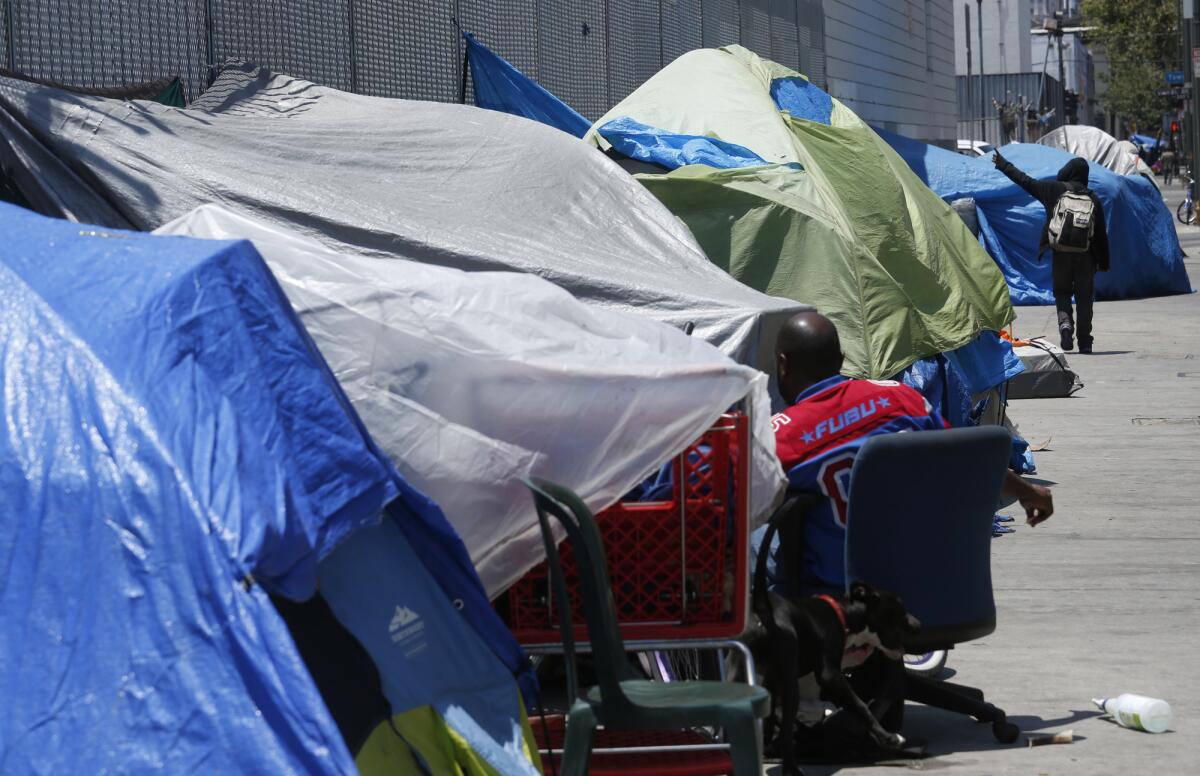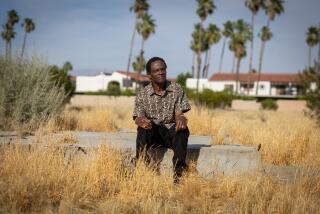Q&A: Proposition HHH would raise funds to build homeless housing in L.A.

Proposition HHH on the Nov. 8 ballot asks Los Angeles city voters to approve a general obligation bond that would raise money to build housing for chronically homeless people.
The proposal involves complicated financing and service arrangements between the city, county and state. Following are answers to some of the questions about the measure:
What would Proposition HHH do?
If the measure obtains the two-thirds vote needed to pass, the city would borrow up to $1.2 billion over 10 years for construction projects to provide “safe, clean, affordable housing for the homeless and for those in danger of becoming homeless.”
The City Council resolution that placed Proposition HHH on the ballot requires that 80% of the money be directed to permanent supportive housing. Up to 20% could be spent on conventional affordable housing without services, and an unspecified amount could be spent on shelters and other measures such as portable showers and storage facilities.
How much would it cost property owners?
As bonds are issued, the annual cost to taxpayers would increase gradually from the first year and peak in 2027, when it would be $18.54 for every $100,000 of assessed valuation. That’s the value the Los Angeles County assessor places on the property, a figure that is generally lower than its market value.
Los Angeles City Administrative Officer Miguel Santana estimates that the average annual cost over the 29 years the bonds are being repaid would be $9.64 per $100,000 of assessed valuation. That would be $32.87 on a home valued at the median of $341,000.
What is permanent supportive housing?
Permanent supportive housing is for people who have been living on the street for a year or more because of mental illness, physical disability or addiction. It primarily consists of apartments with a high percentage of single units in buildings that include space for on-site case managers and clinicians. It is paired with services that can include mental health treatment, addiction therapy and vocational training.
Rent subsidies assure a permanent home as long as the person needs the services.
Who would pay for the services?
Services are provided either by Los Angeles County or private mental health organizations using county funds.
Who would pay for the subsidies?
The Los Angeles Housing Authority has committed up to 1,000 federal housing subsidies per year for the new units as they are constructed. Those vouchers would come from the supply of about 2,100 the Housing Authority distributes each year to eligible applicants who have been waiting since 2003 to get subsidies — effectively allowing them to jump to the head of the line.
What does the housing cost?
Permanent supportive housing costs more to build than comparable market-rate housing. Space set aside for case managers and clinical staff is one factor. The requirements of public funding sources — include prevailing wage, high-energy efficiency and extra-large bathrooms for handicapped accessibility — also raise the costs.
City planning laws result in many projects being proposed at 49 units, even when the underlying zoning would allow more. That’s the maximum that can be built without an environmental review that can add months and raise costs. Smaller buildings with space set aside for services incur larger per-unit costs.
Developers of permanent supportive housing also commit extra resources to gain community acceptance of their projects. For instance, they usually spend extra on architecture to make their buildings visually appealing. They also spend extra on outreach to head off potential backlash over negative perception of their clients.
The Corporation for Supportive Housing, a nonprofit that provides technical and financial assistance to agencies that build permanent supportive housing, estimates the cost in Los Angeles at $350,000 per unit.
A Times analysis of projects funded by the California Tax Credit Allocation Committee, which includes most permanent supportive housing projects, shows that recent projects have usually cost more, averaging about $420,000 per unit in 2016.
How much permanent supportive housing is needed?
In an analysis based on the 2015 homeless count, the Los Angeles County Homeless Services Authority estimated that 25,000 units of permanent supportive housing are needed countywide to serve the portion of the homeless population requiring intense services to live independently. About 9,000 units already exist, leaving a gap of about 14,000. The gap in Los Angeles city is estimated at 9,849.
How is permanent supportive housing financed?
Most projects receive about 65% of their cost from federal tax credits. Under a state-administered program, developers are allocated tax credits that they sell to investors in exchange for equity in the project. The credits currently sell for more than face value because the investors can declare depreciation in addition to the tax credit.
The remainder of the money comes from a combination of local, state or federal subsidies that usually include “soft” loans from the Los Angeles Housing and Community Investment Department that are repaid from excess revenue. Before they can apply for tax credits, developers have to own the land, have an approved development plan and obtain commitments for all the remainder of the financing.
How would Proposition HHH help?
The city plans to contribute up to $150,000 per unit to permanent supportive housing projects, enough in most cases to pay about a third of the cost. That would allow the developer to complete their financing through a less-desirable tax credit program that pays about 35% of a project’s cost. The lower-yield credits are not competitive, meaning that developers could obtain financing quickly for as many projects as they can get ready.
Why is the city focusing on permanent supportive housing?
Based on a growing body of research, homeless advocates generally regard permanent supportive housing as the most effective solution for the chronically homeless who remain on the streets because of mental illness, addiction or disability.
(The research covers topics including Medicaid costs, as well as the impact of housing on the cost of treating homeless people with severe alcohol problems and those who use hospitals. There’s also a map of studies of such costs.)
Why will it take 10 years to build the units?
Currently, a permanent supportive housing development takes about three to five years to complete.
Along with financing, the primary obstacles are land acquisition and the approval process. Both must be completed before a developer can apply for tax credits. Developers of permanent supportive housing compete with market-rate developers for scarce sites suitable for multifamily development in the city. Community opposition to projects geared to the homeless can extend the approval process.
The city is working to shorten the development time by providing excess city land to developers and streamlining the development process.
The City Administrative Office and Housing and Community Investment Department have identified about two dozen city-owned parcels that could be used for housing. Both agencies have received proposals from developers. The City Administrative Office is expected to make recommendations on the proposals
The city’s Department of City Planning is developing a Permanent Supportive Housing Ordinance, which the council is expected to vote on by summer. It would remove regulatory barriers and streamline the entitlement process, shortening the development timeline by up to two years.
Are there any alternatives?
Homeless advocates widely believe that expanding the supply of permanent supportive housing is the only way to reduce the chronically homeless population.
There are skeptics, though, who contend that only a small percentage of the chronically homeless population requires the intense services.
Most of the mentally ill, they say, would be able to function independently in regular apartment buildings with drop-in services provided by mobile providers — the “scattered housing” approach. More expensive permanent supportive housing is necessary only for a small portion of the homeless population, they say.
Proponents of permanent supportive housing say that rental subsidies for scattered housing are less costly than building new units only in the short term. Permanent housing units are subject to rent limits in effect for decades. Over that period, rent subsidies for market housing cost more. Subsidies for scattered housing also require thousands of homeless people to find housing In a tight rental market.
Who will be watching to make sure the money is spent wisely?
An administrative committee of city officials and a citizen committee would be created to provide oversight.
Will Proposition HHH end homelessness in Los Angeles?
Proposition HHH is part of a plan to reduce homelessness to what an analysis for the Los Angeles Homeless Services Authority calls “a less than perfect equilibrium.” That means that chronically homeless people have obtained permanent housing and resources exist so that people who become homeless can be rehoused. Proposition HHH addresses only housing for the chronically homeless. To reach the goal, additional funds need to be spent on rapid rehousing and homelessness prevention programs.
According to the analysis, at least 14,000 people will always be homeless in Los Angeles County until more money is spent to increase the supply of affordable housing.
Twitter: @LATDoug
ALSO
Ballot measure could upset L.A.’s plan for housing the homeless
Fears mount over a homeless plan that residents say will ‘end Venice as we know it’
‘I have a corner of my own’: Santa Ana’s bus terminal-turned-shelter offers the homeless some relief
More to Read
Sign up for Essential California
The most important California stories and recommendations in your inbox every morning.
You may occasionally receive promotional content from the Los Angeles Times.











